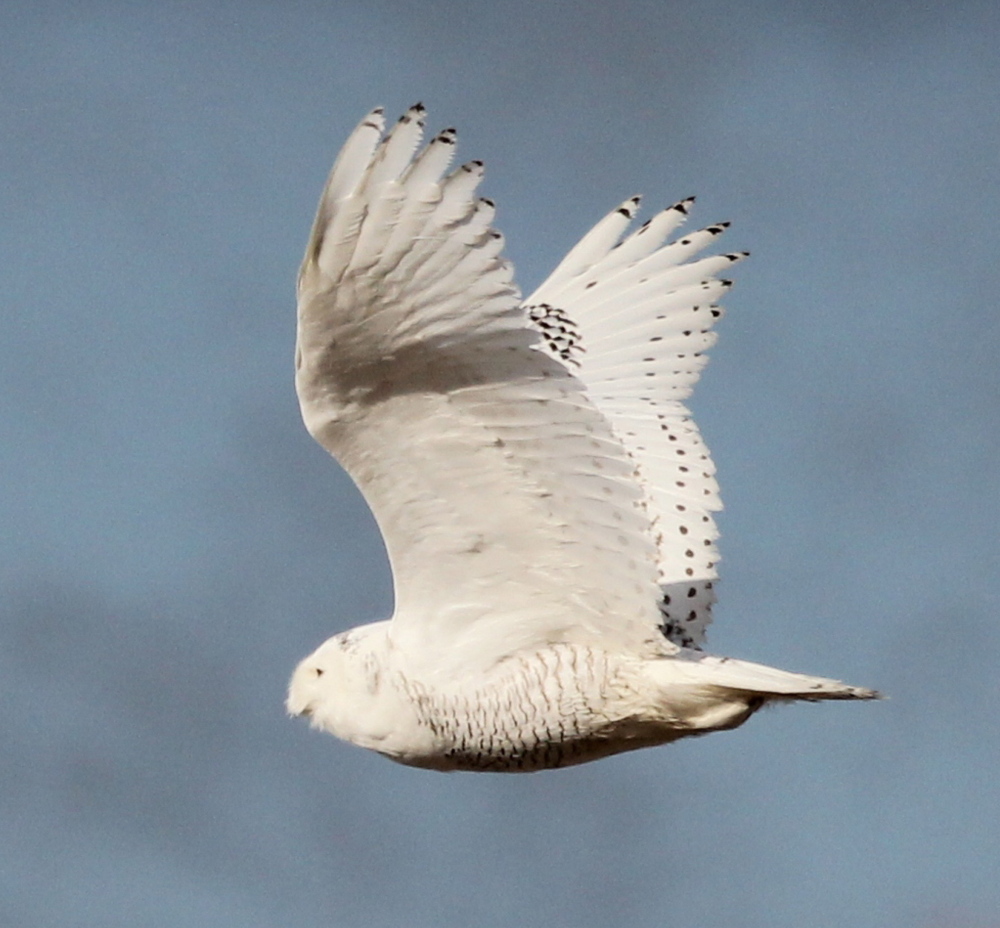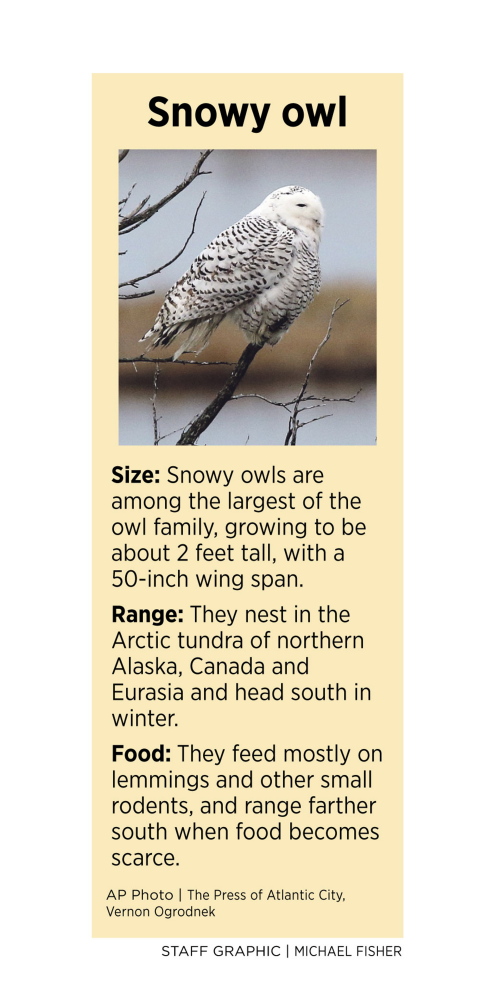They are beautiful, captivating creatures with thick, mostly white plumage and wingspans stretching well over a yard.
And they are starving, forced to leave the Arctic tundra in their native Canada and fly south in search of food.
Snowy owls have come to southern Maine in record numbers this season, as they have across the northeastern United States and the Great Lakes region. From Portland’s Eastern Promenade to the salt marshes of Biddeford Pool, they’ve captured the attention of passersby, photographers and birders.
The beloved birds of prey – more popular in recent years because Harry Potter had a pet snowy owl named Hedwig – have been spotted recently as far south as North Carolina and Bermuda, and they’re posing serious safety hazards at airports large and small because “snowies” prefer wide open spaces.
Snowy owls have collided with at least five planes at airports in the New York area, where authorities have issued shoot-to-kill orders and two of the birds have been shot. Transportation officials haven’t taken any chances since the “Miracle on the Hudson” in 2009, when a disabled Airbus carrying 155 people successfully landed on the Hudson River after flying into a flock of geese.
Concern is equally strong at the Portland International Jetport, where authorities and birders have seen several snowy owls. Two of the birds were shot after they ignored “hazing,” when airport staffers attempt to disburse wildlife by setting off fireworks that screech and bang.
“It’s the first time in memory that we’ve had to take snowy owls,” said the airport’s director, Paul Bradbury, who said he saw a snowy owl recently while he was jogging on the Eastern Prom.
The U.S. Department of Agriculture oversees the airport’s wildlife hazard management program, Bradbury said. Certain airport staffers are specially trained to deal with any wildlife that ventures near runways and may cause accidents when planes are landing or taking off, from deer to Canada geese.
Bradbury said his staff is working with USDA officials to develop a program to trap and move wildlife, rather than shoot it.
While the prevalence of snowy owls presents a public safety challenge for airports, it’s a boon to birders like Marie Jordan of South Portland, 75, who has loved birds all her life and became a serious bird watcher 20 years ago.
Jordan has ventured to Biddeford Pool several times in recent weeks to admire the owls from afar and take pictures of them with a telephoto lens. She saw six one day last week. As many as 12 have been spotted there in recent days.
“In my lifetime, I’d only ever seen two of them at one site,” Jordan said.
Most of the snowies seen in southern Maine are young males and females, born last summer. They can be identified by the black barring on their mostly white feathers. Mature adult males usually are completely white, and more likely to stay closer to their home range.
The younger owls have been forced to move south because their favorite foods – lemmings and other rodents – are in short supply, said Doug Hitchcox, staff naturalist at Maine Audubon.
That’s likely because the snowy owl population in northern Quebec surged this year, Hitchcox said, with some researchers noting record numbers of nests, larger clutches and parent owls piling up lemmings around some nests.
Female snowy owls adjust their egg production to food availability, laying more eggs when the lemming population is high, Hitchcox said. Then, when the owl population swells, the lemming population falls, in part because an adult snowy owl can eat as many as five lemmings a day.
“It’s nature’s way of controlling populations,” Hitchcox said.
If lemmings are too scarce when winter comes, snowy owls must fly south. Hitchcox said it’s not uncommon for a few snowies to visit southern Maine each year, but the high numbers this season are extraordinary.
“They’re down here because they’re starving,” he said. “These birds are desperate, they’re under stress, and they’re going as far south as it takes to find food.”
Around here, snowy owls are looking for mice, voles, squirrels and other rodents, Hitchcox said. They’re sitting on rooftops and other high places, using their fine hearing and eyesight to prey on critters in nearby marshes and fields.
They’re also fending off lots of unwanted attention. Because they’re rather docile, snowy owls will allow humans to get relatively close. They also remain still because they’re trying to conserve energy and avoid being seen, which is their habit in a white landscape.
“Just because they’re approachable doesn’t mean they’re OK with it,” Hitchcox said. “The best thing people can do is give them as much distance as possible.”
Kelley Bouchard can be reached at 791-6328 or at:
kbouchard@pressherald.com
Twitter: @KelleyBouchard
Copy the Story LinkSend questions/comments to the editors.




Success. Please wait for the page to reload. If the page does not reload within 5 seconds, please refresh the page.
Enter your email and password to access comments.
Hi, to comment on stories you must . This profile is in addition to your subscription and website login.
Already have a commenting profile? .
Invalid username/password.
Please check your email to confirm and complete your registration.
Only subscribers are eligible to post comments. Please subscribe or login first for digital access. Here’s why.
Use the form below to reset your password. When you've submitted your account email, we will send an email with a reset code.